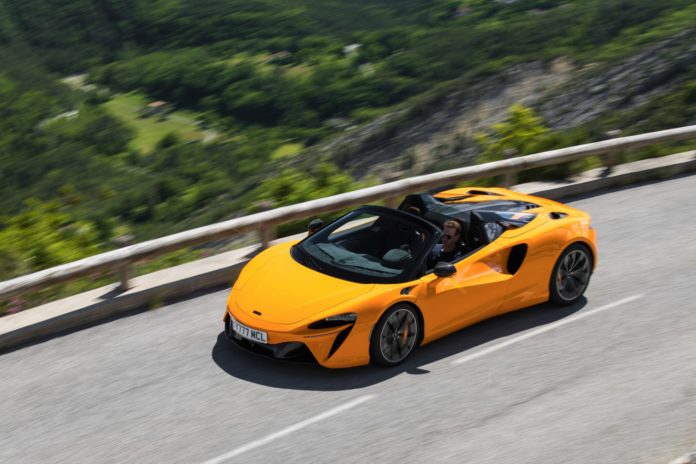Usually, when it comes time for an automaker to rip the covers off its latest roadster, we’ll first hear not about what’s changed but what hasn’t. Brands will boast about the rigidity of their chassis, requiring little or no additional strengthening, or even brag about the Spider’s time to 60, often matching the coupe. Unveiling a convertible take on a well-known hard top can be quite a non-event. As long as it accelerates, stops, and steers like the coupe that preceded it, that’s it; job done. However, that’s not the case with the 2025 McLaren Artura Spider. There’s far more at stake here.
At this point, the seemingly endless list of challenges and setbacks McLaren faced while trying to ramp up production of the Artura are more than well documented. It’s the almost unavoidable result of attempting to produce a car whose chassis, engine, transmission, and electrical systems are all new, especially one that integrates an axial-flux electric motor sandwiched between this new hardware. However, the impacts of this complexity extend beyond the production line, with reliability concerns looming and detracting from what was otherwise one of the most thrilling supercars I drove in 2022.
As such, the 2025 McLaren Artura Spider has to be more than a roofless variant of the coupe we’ve come to know if it’s to sway hesitant fans of the brand. To this end, practically every component McLaren could’ve updated has been. It arrives alongside a reworked coupe, which for the 2025 model year also produces 19 extra horses, benefits from a reworked power curve, rips shifts 25 percent faster, howls thanks to a de-restricted Sport exhaust system, and whose suspension has been revised to maximize driver engagement.
I flew to Monaco for a drive through twisting, lusciously green mountain roads, vast highways that cut through the French Riviera, and finally, right up to the Casino de Monte-Carlo to find out if the Artura has finally reached its full potential.
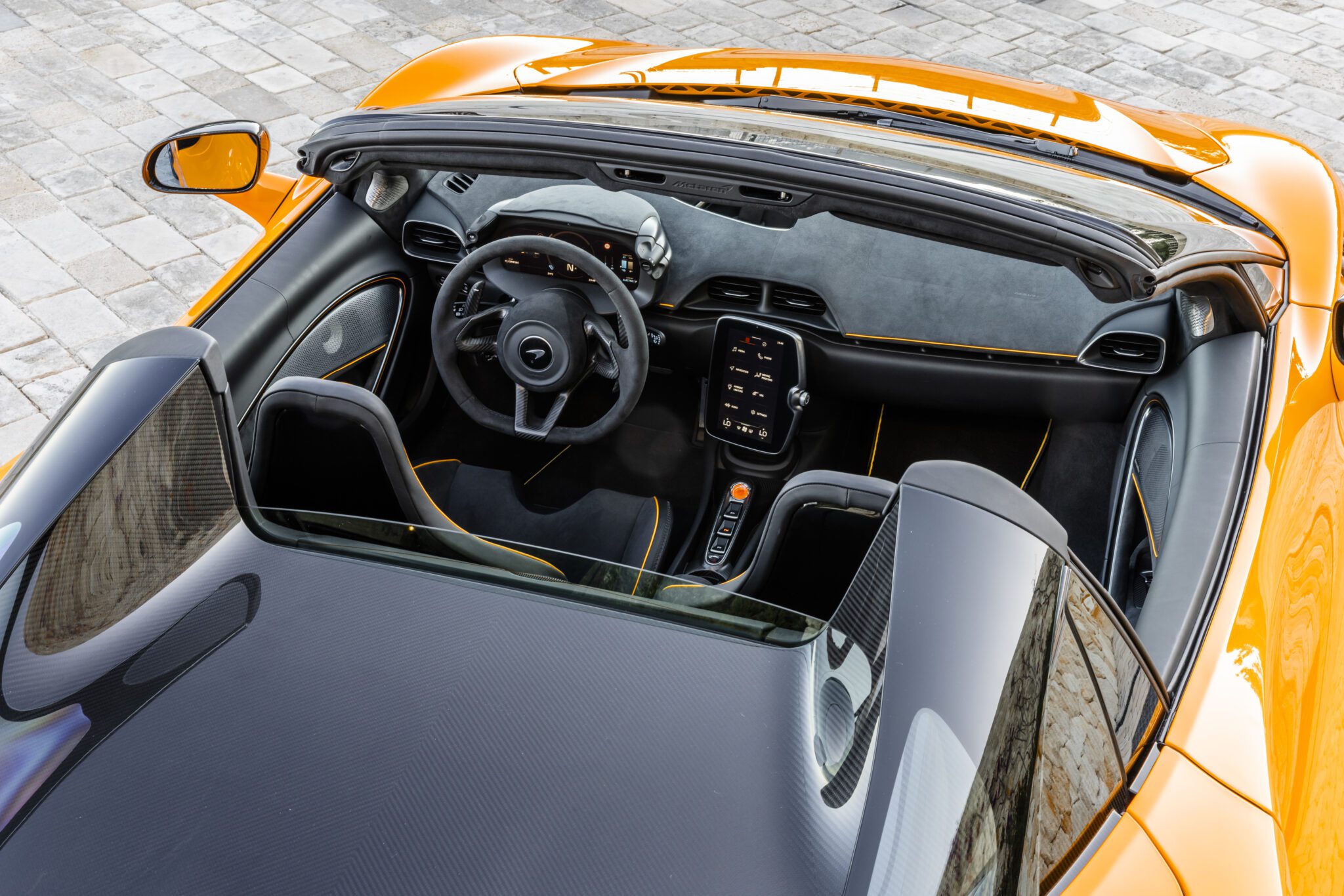
Sliding into the Artura Spider’s fixed-back Clubsport seat early in the morning, I set off silently from my hotel on the French Riviera. Like the Ferrari 296 GTB and the SF90, the Artura circumvents the need for a traditional starter by utilizing its axial-flux electric motor to get going. Nestled within the bell housing of its eight-speed transmission, it weighs just 34 pounds yet produces 94 horsepower and up to 166 pound-feet of torque. Crucially, it allows you to crawl away unnoticed and keep going for up to 11 miles thanks to its 7.4-kilowatt-hour battery pack.
As I joined the highway leading west towards Nice, its twin-turbocharged 3.0-liter V6 burst into life in a seamless transition into gas-powered propulsion. Unassisted by the electric motor, it develops 596 hp, a 19-hp increase. However, the bit worth focusing on here is how the software responsible for these gains reshapes its power curve, with most of its output now concentrated between 4,000 and 8,500 rpm. Its electric motor feeds plenty of power down in the rev range, thus eliminating the effects of turbo lag as its V6 hits its stride. As a result, the Artura pulls tremendously hard to the redline, now riding one unified wave of power and torque.
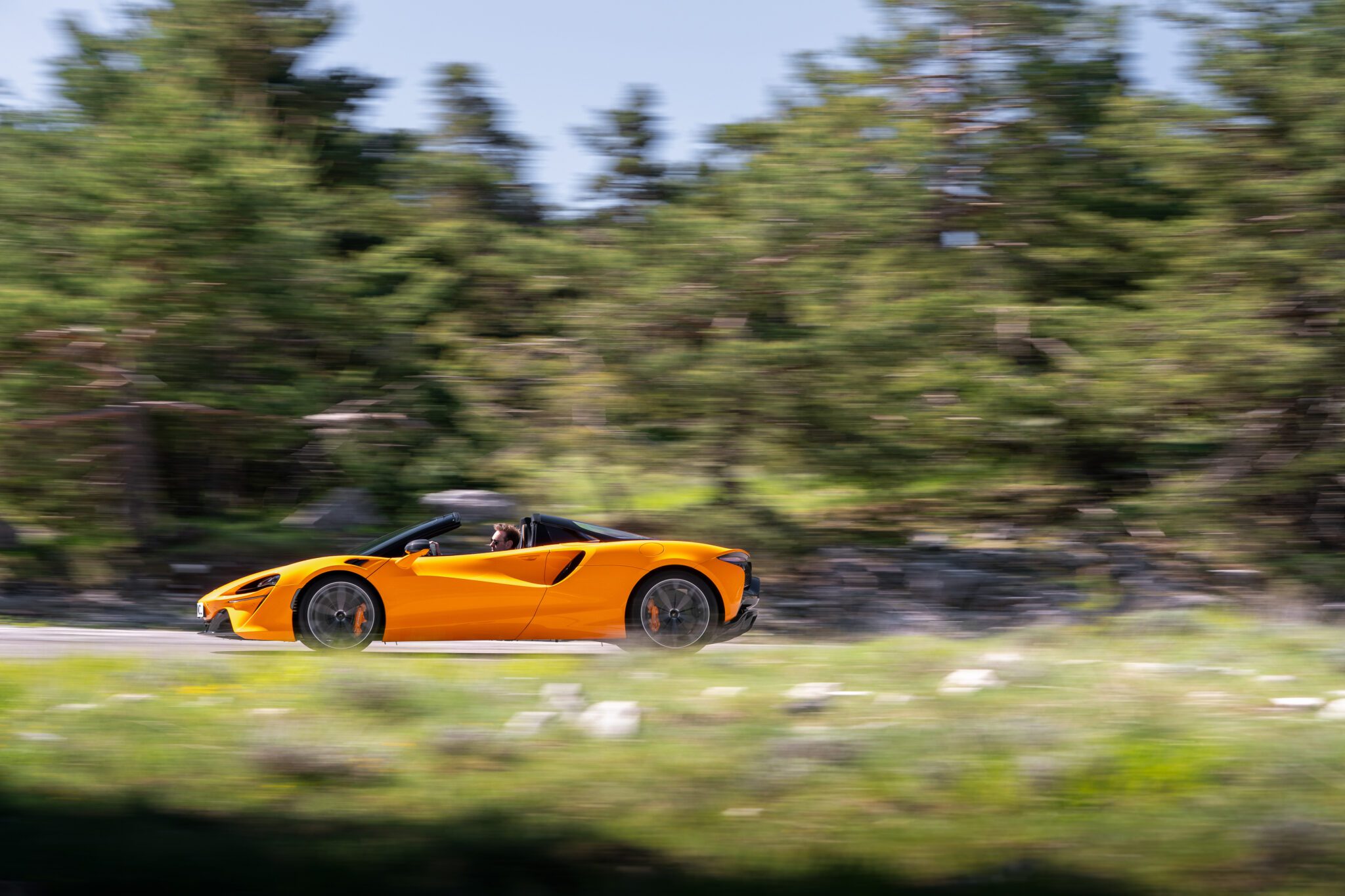
Pull the right paddle, and its eight-speed shifts up to 25 percent quicker by anticipating the next gear. Although its reactivity is primarily drive mode dependent, it’s nearly seamless in Comfort mode but quickly sharpens in Sport and Track. Blitzing through mountain ranges sitting in the left lane, the Artura Spider cruises at triple-digit speeds, its V6 fading into the background as if ready to carry on for thousands of miles. With its handling mode set to the same Comfort setting, it delivers the excellent ride quality McLaren is famous for. It’s only made better by a new responsive domain control unit, which can scan the road surface and adjust its dampers up to 90 percent quicker.
Turning off the highway, I flicked the powertrain selector back down to Electric mode to silently traverse the small towns on the way to the mountains. Once there, I dialed the powertrain and handling modes up to Sport, which keeps its V6 engaged at all times. As with the 750S I tested earlier this year, McLaren’s engineers have reworked this mode to be the most vivid, allowing you to bounce off the rev limiter and deliver the most aggressive shifts. This thoughtful recalibration pairs with a louder optional $5,100 sports exhaust and firmer engine mounts, which transmit more powertrain and chassis feedback to its driver.
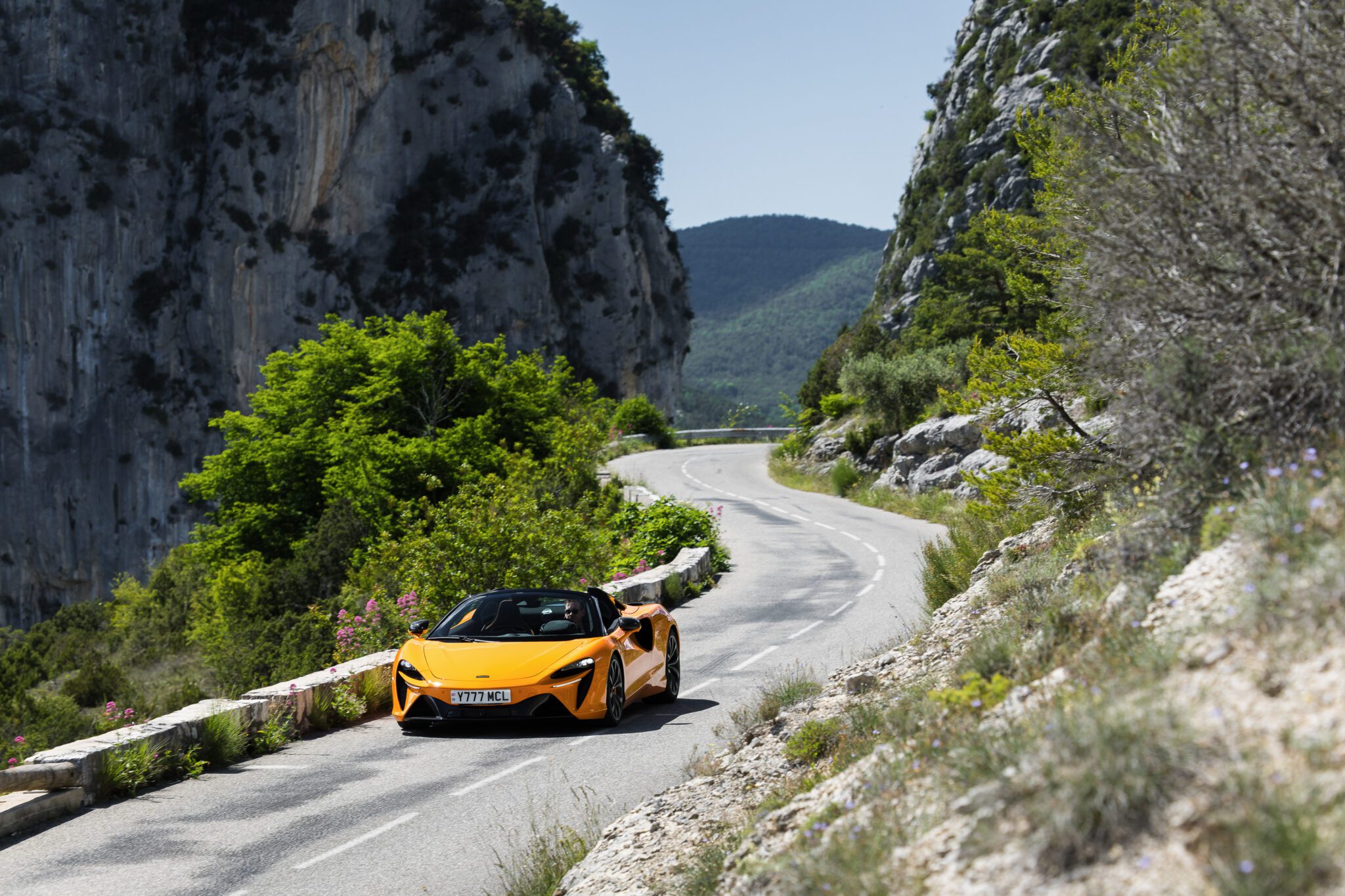
Configured for full attack, the McLaren Artura Spider produces a total system output of 690 hp and 531 lb-ft, which, in a car boasting a curb weight of 3,439 pounds, results in a three-second-flat sprint to 60mph. Commit to full throttle, and you’ll blast past 124 mph in 8.4 seconds and 186 mph in 21.6 before maxing out at its electronically limited 205-mph top speed. These are massive figures for a car in which to negotiate winding, narrow, and undulating French mountain roads. And while squeezing that total output is still challenging outside of a track, the Artura’s closely spaced gears mean you’re constantly moving up and down its eight speeds.
As I worked my way between massive rows of trees, dodging the occasional cyclist and climbing up the mountains, the Artura’s 120-degree V6 filled the woods with glorious noise. Unlike a more traditional 90-degree configuration, which can often sound raspy and unrefined as you reach its redline, this Spider’s note is distinctly exotic. It sings a smoother and unified song, now made more enjoyable thanks to its de-restricted exhaust.
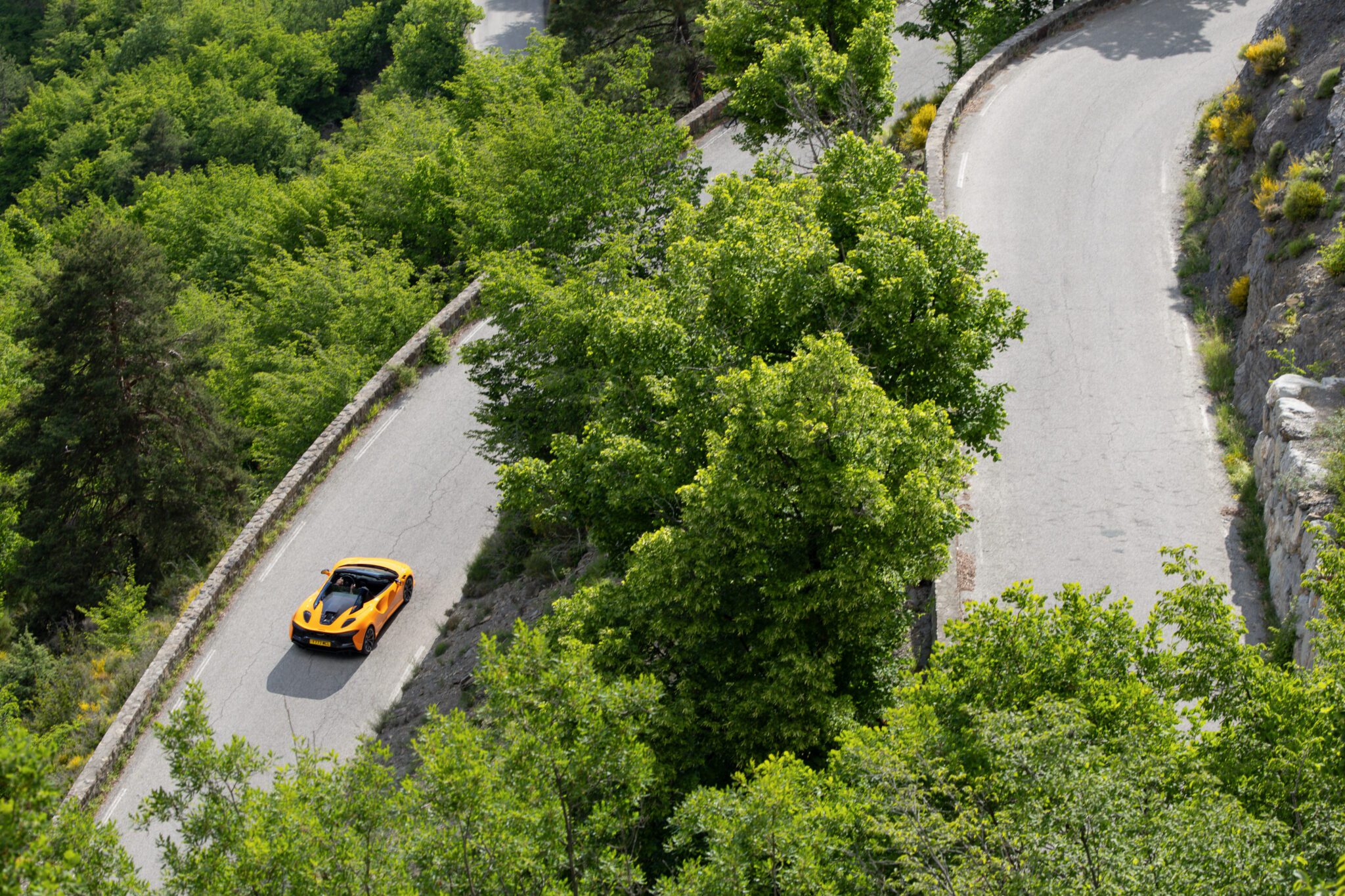
Diving into hairpins, it immediately becomes clear how light the McLaren Artura Spider is, with its front end feeling agile and eager to follow your inputs. Weighing 136 lb over its coupe counterpart, most of the Spider’s gains come from its folding roof mechanism, with its carbon fiber monocoque requiring no additional strengthening to retain its rigidity. Compared to its closest competitor in price and performance, the Maserati MC20 Cielo, the Spider is still 183 lb lighter despite housing a battery pack and an electric motor. This is because its hybrid system only contributes 287 lb to its overall weight.
As such, from behind the wheel, you don’t get the sense that the McLaren Artura Spider is dialing out unwanted body motions or masking its heft. Turn the wheel, and it’ll intrinsically follow where you want it to go with excellent grip from its front end. This is doubly impressive in the Spider, which exceeds the outgoing coupe’s dynamic capabilities. Approach the next bend, and you’ll have to apply firm pressure for its standard carbon-ceramic brakes to clamp down properly. However, after an initial stomp, they’re easy to modulate.

Although McLaren made no physical changes to the Artura’s steering, its firmer settings in Sport and Track modes contribute to a weightier and crucially more communicative wheel. There are new faces in this car’s development team, some of whom cut their teeth developing now-iconic machines for the prancing horse, and it’s evident from an engagement perspective. Although the outgoing Artura was a thriller, this latest iteration dials up practically every aspect of the driving experience. From increased steering feedback to more chassis vibrations making their way through its standard bucket seat to your back, there’s a level of engagement on offer previously reserved for cars like the 750S.
Dialing up to Track mode for its powertrain and handling settles the experience, which is an intentional move, say McLaren’s engineers. With its goal being the quickest lap times, it’s not interested in delivering thrills, just speed. As such, it’ll shift at the optimal point in automatic mode, not necessarily going to redline, while the eight-speed dials back shift aggression in favor of moving through them more quickly. It’s a track-only mode in both name and spirit, delivering no noticeable improvements on the road. This is also intentional, with each mode learning your driving habits and the road and adapting to suit the conditions. Truly clever stuff.
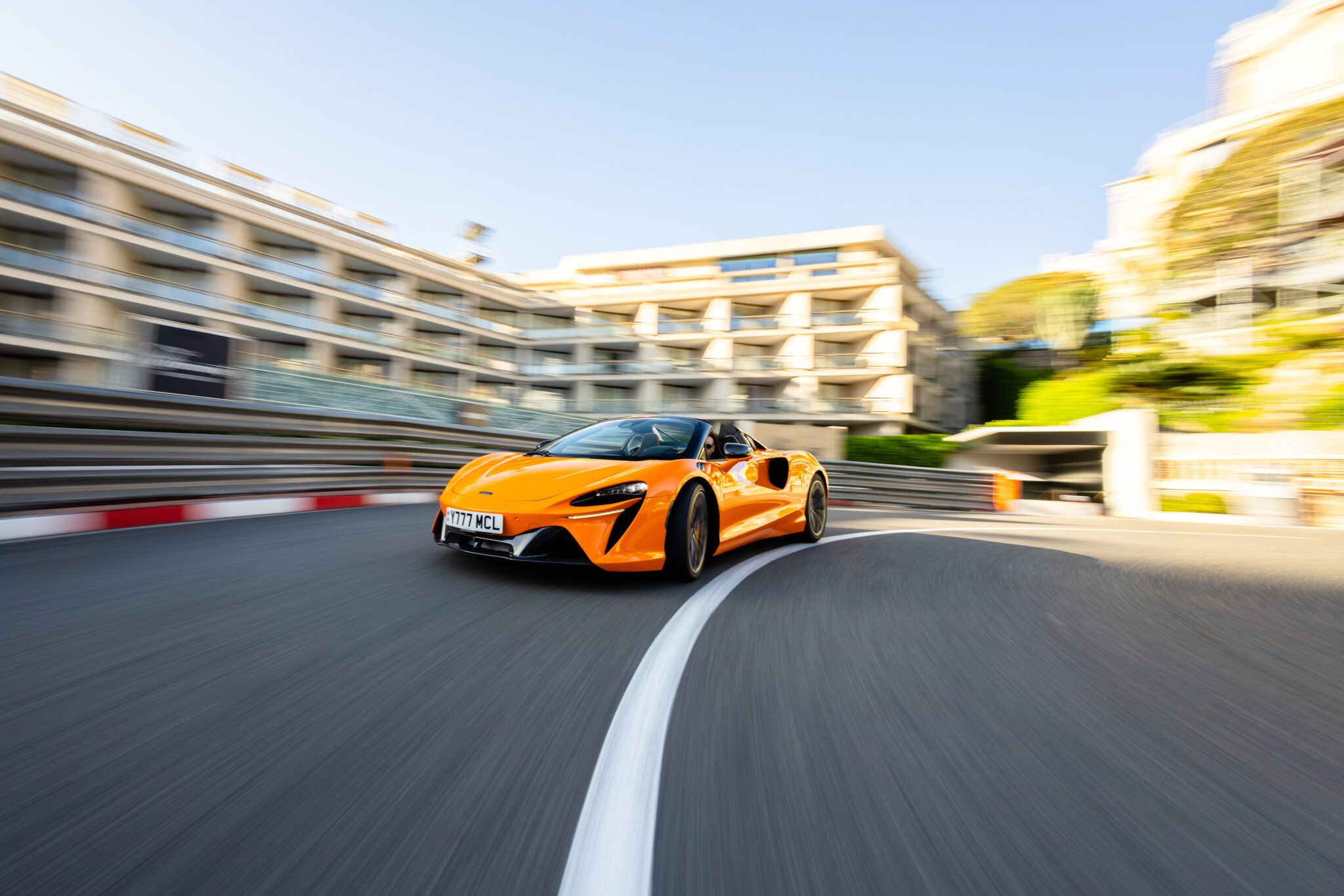
Winding down and out of the mountains on the other side with the Artura’s nose pointing back towards Moncao, I settled in for yet another highway cruise, a perfect time to poke around the cabin. From here, it’s clear that McLaren doesn’t just want the Artura to be a car reserved for special occasions. While its dual-screen layout, including smartphone connectivity, carries over, it now gains new driver assistance features for 2025, including lane-departure warning (which can be permanently deactivated) and road sign recognition as standard. Adaptive cruise control, blindspot monitoring, and rear cross-traffic alert are optional extras.
Despite being a proper mid-engined supercar, the Artura is strikingly comfortable, even when optioned with its standard Clubsport seat (comfort seats are available). There’s plenty of head and shoulder room, at least enough for your 5’10 author, and excellent visibility all around, thanks mainly to its large windows and glazed rear buttresses. Aside from contributing to its cabin feeling airy and open, they’re functional, channeling airflow into the engine bay as part of the Spider’s unique cooling system. Eight silent electric motors fold its metal roof in 11 seconds at speeds of up to 31 mph.

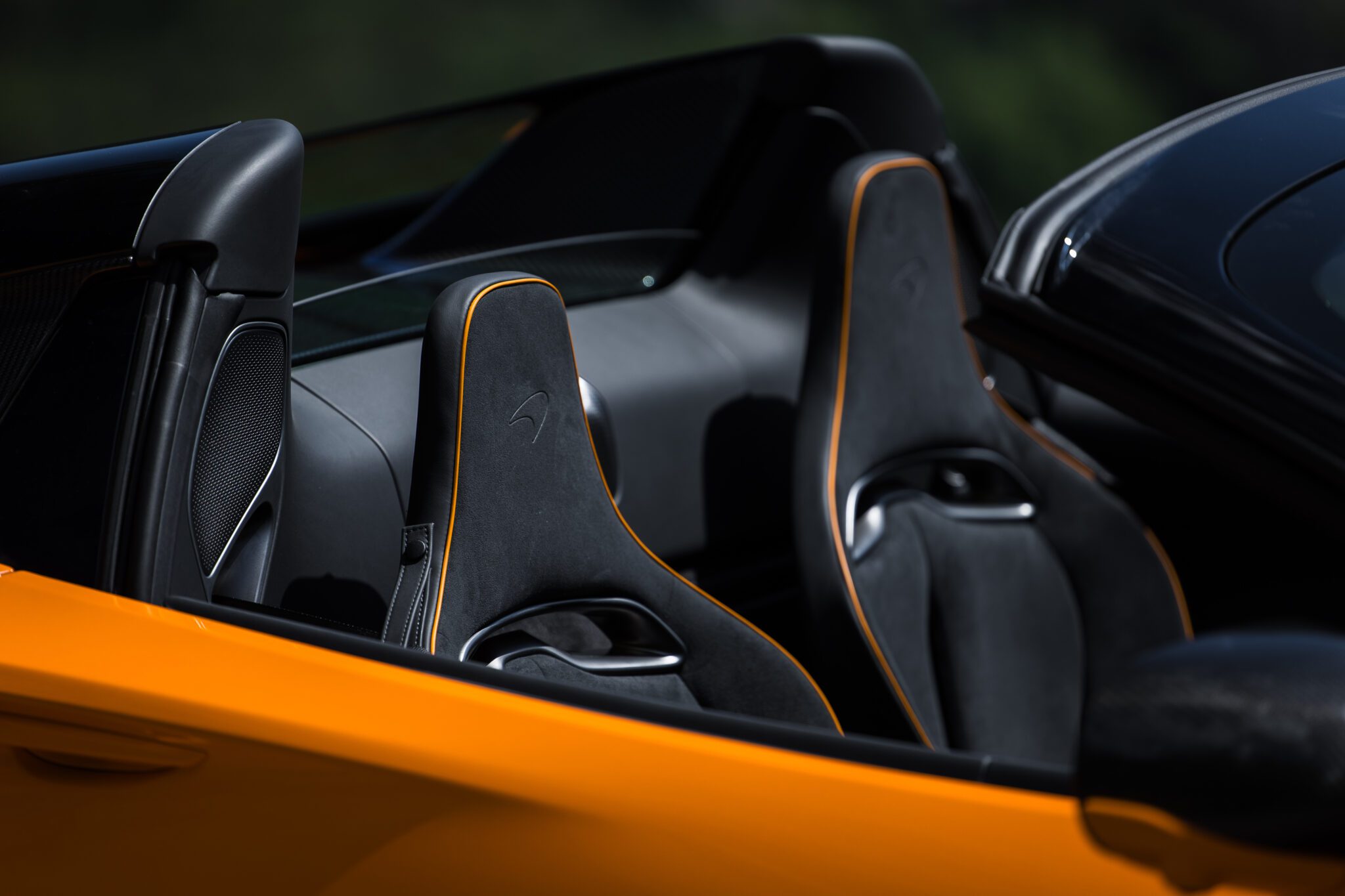
Navigating through Monaco’s tight city streets, often turning onto and off the Formula 1 track, is daunting. With summer approaching, the number of tourists, car spotters, and the occasional locals hit the streets in droves. However, aside from repeatedly getting lost en route to the Casino de Monte-Carlo, there’s little to report behind the wheel. As I experienced up in the mountains, the Artura is happy to take you wherever you wish, sitting comfortably on a highway, blitzing through mountain roads, or puttering along in traffic; it’s adaptable.
When the McLaren Artura Spider arrives on US shores, it’ll cost $281,008, including a $5,000 destination fee and the $2,208 America Accessories Pack. The updated coupe that arrives alongside it costs $256,308, including fees. Each comes with a five-year unlimited-mile warranty and three years of service. Crucially, McLaren offers owners of the outgoing Artura Coupe the latest engine software free of charge.
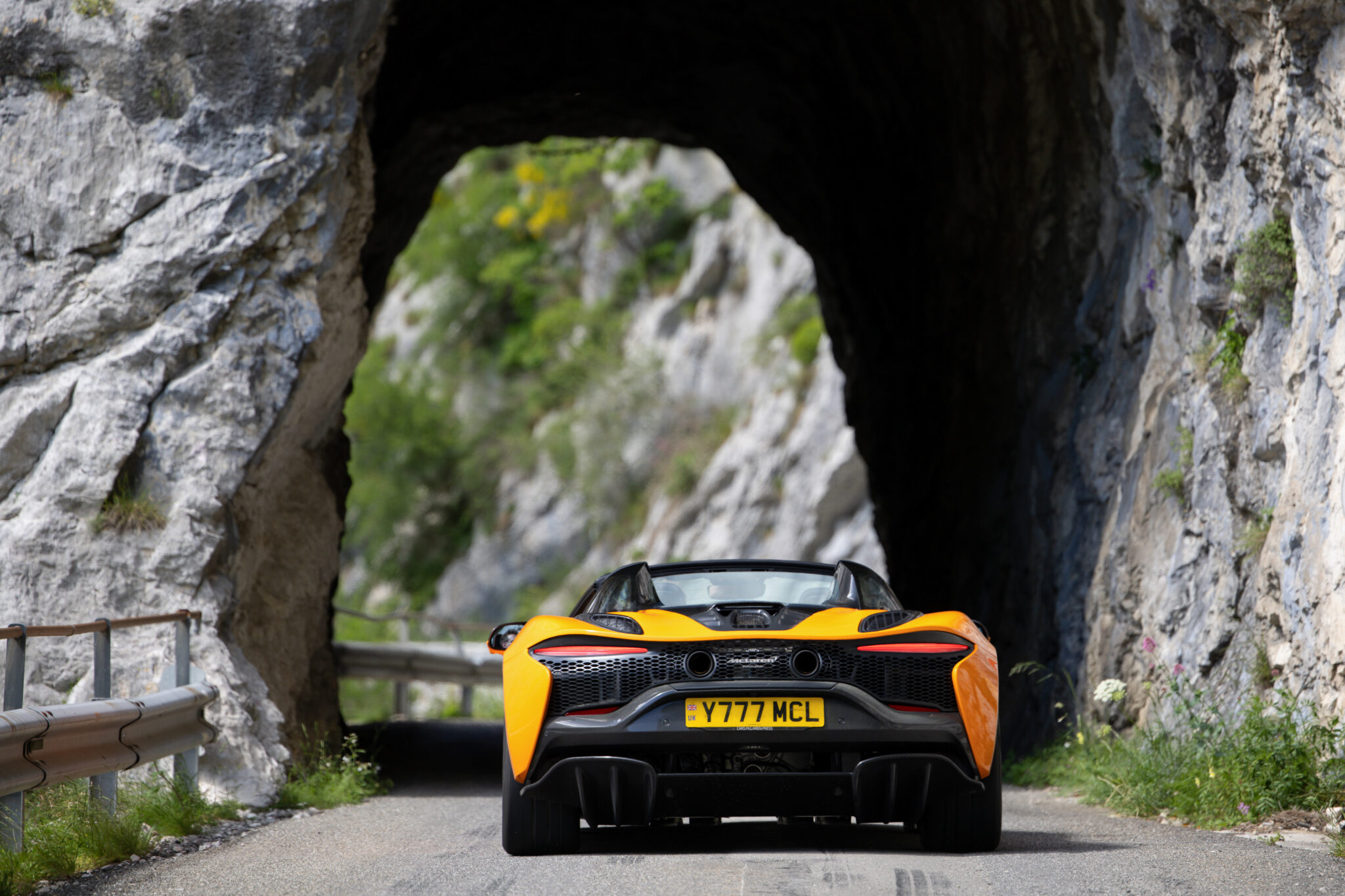
After hours on the move, I hopped out and handed the keys of the unscathed Artura back, parked at the steps of the Hotel de Paris across from the famous casino. As I’d hoped reading through its spec sheet ahead of the drive, the Artura Spider is far more than just a convertible take on the car I drove nearly two years ago. By implementing thorough and thoughtful updates, McLaren has taken a solid foundation and turned it into a more exciting supercar that feels alive not just for brief moments on perfect roads but comfortable for long journeys and easy to pilot through crowded cities.
The Artura Spider stands out as one of the most usable supercars I’ve tested to date, a claim I’ll explore later. Later this year, it’ll become duPont REGISTRY’s first long-term test vehicle. It’s not that its driving experience vastly differs from the car it replaces; it’s been diligently dialed in. Be it new input from an expanded development team or simply having more time and experience working with the platform, this latest update finally gives the Artura the necessary tools to deliver its best.


